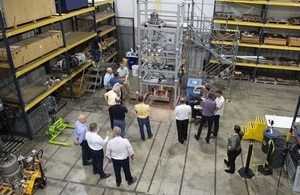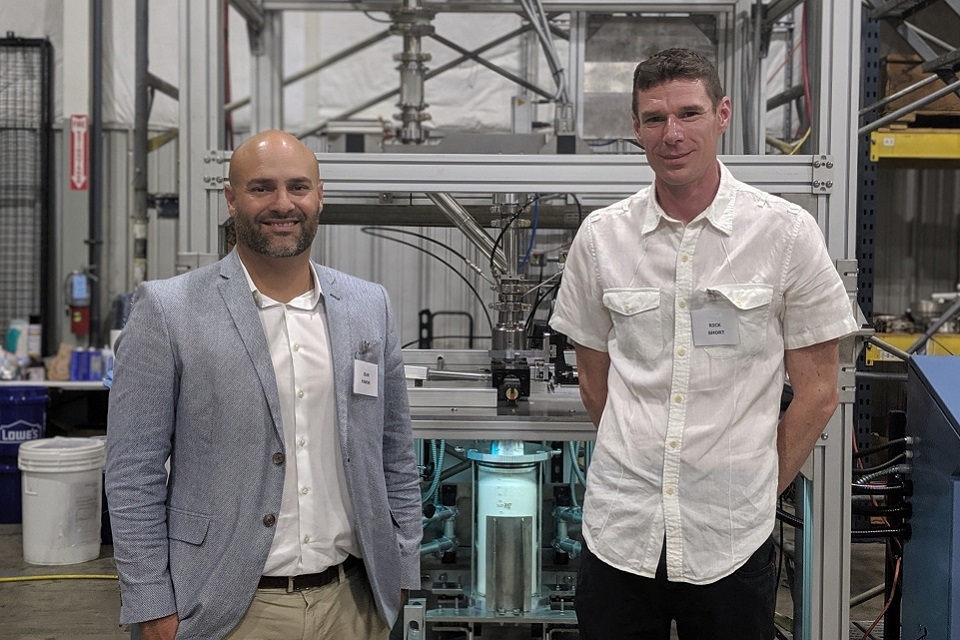Hot Isostatic Pressing (HIP) for plutonium
As part of ongoing research into technologies for immobilising plutonium, the NDA has embarked on a collaborative project with the US to examine the feasibility of a can-filling treatment in preparation for Hot Isostatic Pressing (HIP).

Observers at the can-filling demonstration rig in the US
Challenge:
To identify a suitable technology for filling cans with plutonium and glass-forming materials, as part of ongoing research into Hot Isostatic Pressing (HIP).
Solution:
Joint investigations into aspects of an existing HIP treatment currently used for other materials
| Benefits | Consolidation and stabilisation of plutonium for long-term storage |
| Status | Analysis currently taking place of technology offered by existing supplier to establish if it can be successfully adapted |
| R&D driver | Informing strategy |
| Research organisations | NNL |
Details
The HIP process could blend the plutonium with a glass-forming material, creating a solid that may be suitable for storage and eventual disposal.
The UK has large quantities of non-military plutonium, which is safely and securely stored in powder form at Sellafield. Potentially of value as a component in new reactor fuel, the UK government is in the process of establishing whether to take forward this option, or to dispose of the plutonium. Whichever option is selected, some will remain unsuitable for re-use.
Assessing technologies that are, or could be, available to deal with the plutonium is one of the most complex challenges facing the NDA as it provides information to the government on possible options.
Hot Isostatic Pressing (HIP) is a heat-plus-pressure treatment which has been used in industrial processes for a number of decades, including the nuclear industry, and can convert various materials into a glass-ceramic or ceramic form. HIP technology offers a potential future immobilisation solution if it can be successfully adapted and deployed on large-scale basis.
The US Department of Energy (DoE) is currently experimenting with HIP equipment to process an inactive simulant of calcined (heat-treated) waste. The NDA has been able to collaborate with the DoE to develop a key aspect of the HIP process: filling the HIP cans.
Collaboration on the project provides value to the taxpayer and supports knowledge exchange between the two countries, recognising synergies in the requirement to deal with UK plutonium.
A quantity of non-radioactive simulated plutonium wasteform, containing a glass ceramic-forming mixer, was shipped to the US for the trials. The alpha and gamma radiation characteristics of UK plutonium require complete isolation from any human contact, so all solutions must be applied using remotely operated technologies to avoid contamination of people or external surfaces/equipment. Among key issues to assess was how the powder would be fully contained as it is fed from a container through a fine tube into a canister for the HIP process.
NDA Research Manager Rick Short observed the US trials in progress and noted the successes of the work to date. He also emphasised that continued progress and modifications are needed, for example to ensure that no residue would remain outside the canister.
Developing these key process steps on an industrial scale is a key step towards identifying a process as a potential final solution for plutonium immobilisation.
The US trials were partially successful but further modifications are required to ensure the integrity of the process so that no residue remains outside the canister. Developing these steps on an industrial scale is key towards identifying a process as a potential final solution for plutonium immobilisation.

Rick Short and the DoE's Jean Pablo Pabón Quiñones in front of the HIP rig
The US trials will contribute to identifying the best technical solutions for immobilising the plutonium. Current research projects are focused on HIP technologies and include:
- Trialling HIP with real plutonium on a small scale
- Investigating industrial-scale HIP using an inactive plutonium substitute
The outcome of all the research will be taken into account when the NDA provides advice to government in 2020 on options for plutonium disposition. The government’s final policy decision will take into account a wide range of factors including technical feasibility, security issues, costs and benefits.
Further reading
This case study is part of the Direct Research Portfolio Report 2018 to 2019
Also available is the previous DRP Report 2017 to 2018